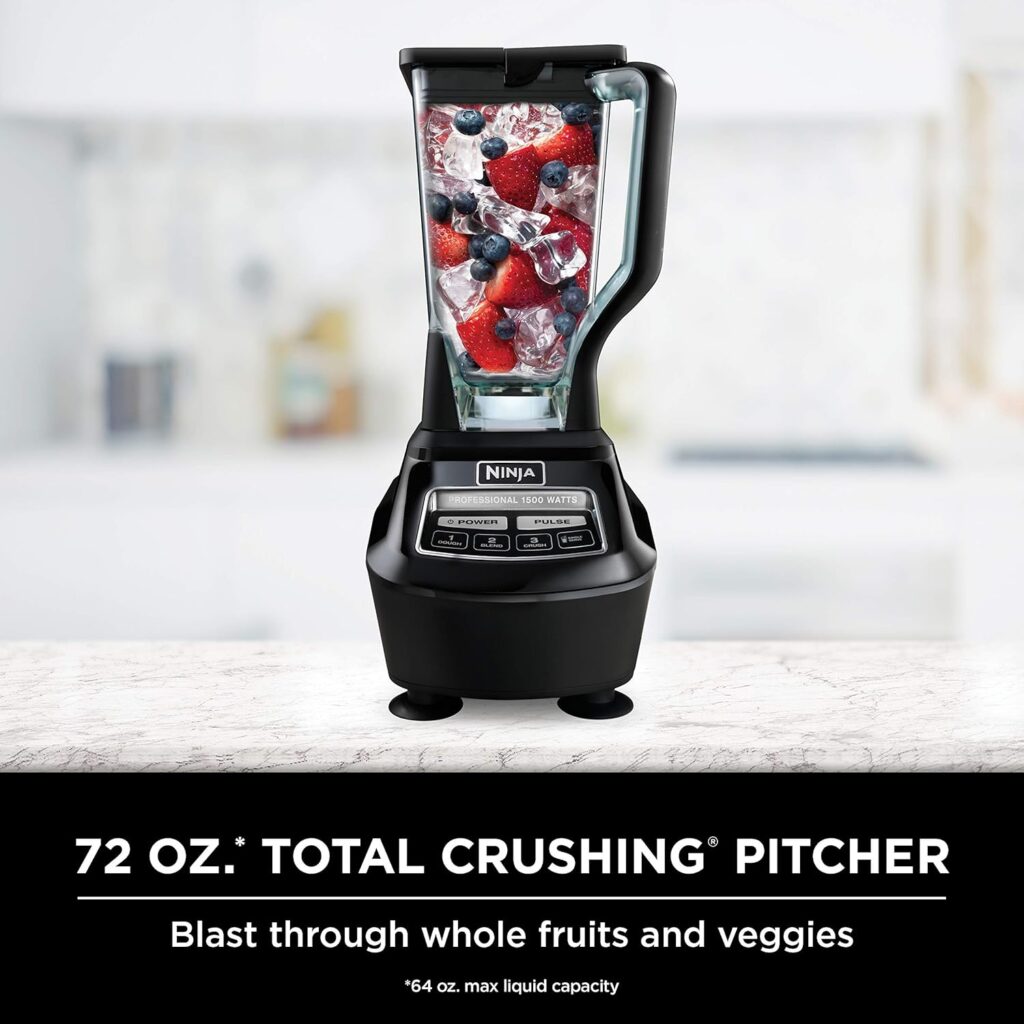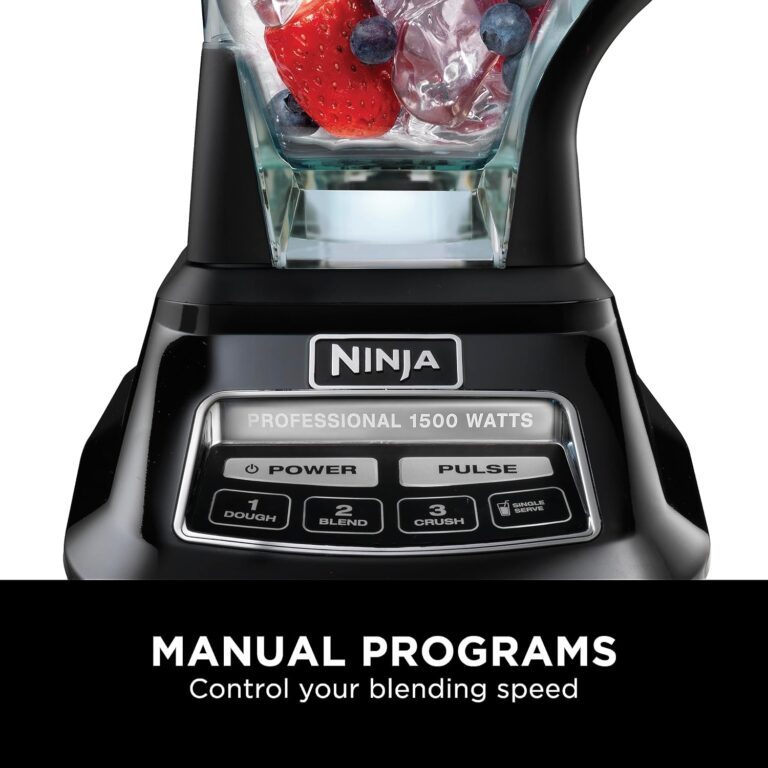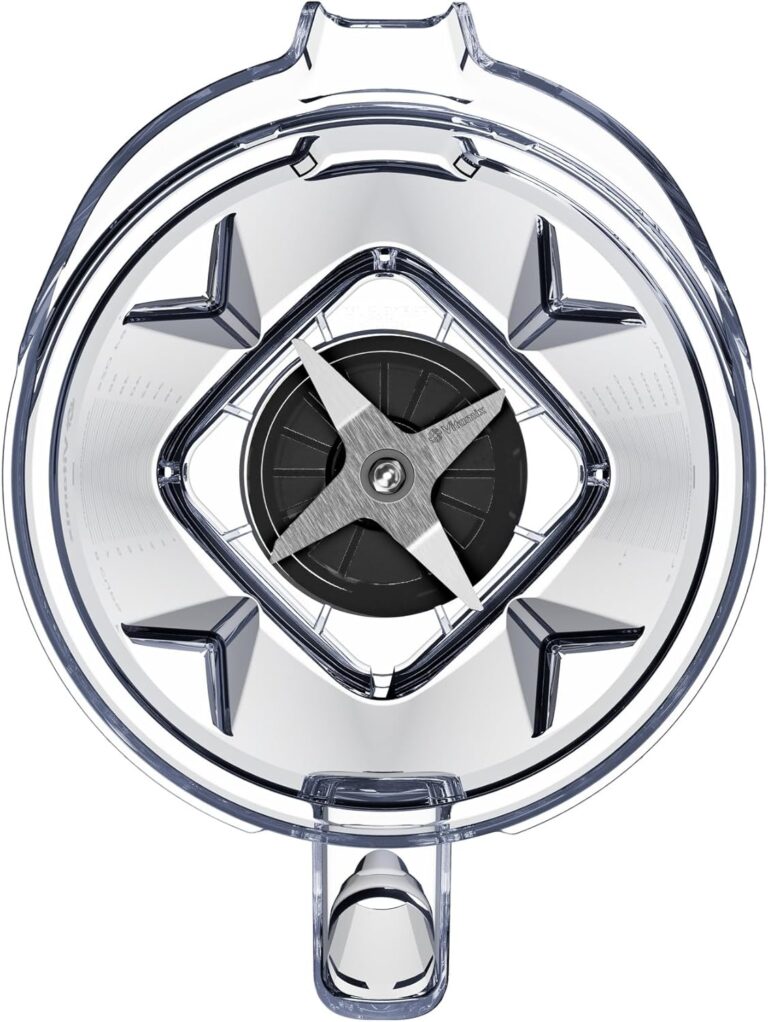
The Ninja Blender Compact Kitchen System offers the best of both worlds — powerful blending paired with food processing functionality — all in a more counter-friendly size compared to larger Ninja models. But just like any high-performance appliance, it needs proper maintenance to perform its best and last for years.
In this guide, you’ll learn how to properly clean, maintain, troubleshoot, and extend the lifespan of your Ninja Compact Kitchen System. We’ll cover everything from daily cleaning to blade care, deep deodorizing methods, and storage tips. Whether you’re using it for smoothies, dough, or meal prepping, these easy maintenance routines will keep your machine running like new.
If you want a full breakdown of the Compact Kitchen System’s blending performance, pros, and cons, check out our Ninja Compact Kitchen System hands-on review.
Why Proper Maintenance Extends the Life of Your Ninja Compact Kitchen System
Many users assume wiping down the blender jar is enough. However, because this Ninja system blends, processes, and handles dough, it faces more intense workloads than a basic blender. Without proper maintenance, issues like gasket leaks, motor strain, blade dulling, and mold buildup can occur.
Here’s why consistent cleaning matters:
- Multi-Use Stress: The motor is designed to handle both liquids and heavy doughs, but leftover residues stress the components if not cleaned.
- Blades Under Load: Thick mixes like dough and frozen fruits can leave buildup under the blade hubs if not washed immediately.
- Gasket Wear: Dirty seals degrade faster, leading to leaks and container instability.
- Motor Cooling: Dust and food particles blocking motor vents increase the risk of overheating.
By investing a few minutes after each use — and scheduling monthly deep cleans — you’ll dramatically extend the machine’s life and keep it operating at peak power.
Quick Daily Cleaning Routine for Busy Kitchens
After every use, especially with sticky, doughy, or protein-heavy blends, follow this simple 2-minute routine:
- Disassemble Components: Remove the pitcher, processor bowl, blade assembly, and lid.
- Warm Water Rinse: Quickly rinse off visible food debris with warm water.
- Soap Soak and Blend: Fill halfway with warm water, add 1 drop of dish soap, and pulse for 20 seconds.
- Scrub Key Areas: Use a soft sponge or bottle brush to clean under blades and inside corners.
- Rinse Again Thoroughly.
- Air Dry Fully: Dry upside down to avoid moisture collecting in seals or under blades.
Skipping this routine even once can allow residue to dry, making deep cleaning harder later.
Deep Cleaning the Pitcher, Bowl, Lids, and Cups
At least once a week (or after heavy recipes):
- Fill containers halfway with warm water + 1 cup white vinegar.
- Let soak for 20–30 minutes to break down food oils, stains, and smells.
- Scrub lids and gaskets separately with a toothbrush or gasket-safe brush.
- Pay special attention to handle areas where grime can hide.
- Rinse thoroughly and dry upside down.
For heavy stains (like turmeric or green juices), blend a mix of lemon juice and water for a natural whitening refresh.
Blade Assembly and Gear Maintenance
The Ninja Compact comes with stacked blade towers and food processor blades that experience major torque during use.
Neglecting them leads to:
- Food buildup under hubs
- Blade dulling from hidden residue
- Gear connection strain
To care for blades:
- Rinse immediately after blending.
- Soak blade hubs once a week in warm soapy water for 10 minutes.
- Brush under and around blades carefully.
- Never use hard scrubbing pads that could dull the blade edges.
- Dry immediately to prevent rust spots or mineral deposits.
Cleaning and Caring for the Motor Base
The motor base is the heart of your kitchen system — and it must stay clean and dry:
- Unplug first before wiping.
- Wipe down exterior with a damp microfiber cloth weekly.
- Clean air vents gently with a soft brush or compressed air monthly.
- Dry the control panel immediately if spills occur.
- Never submerge or rinse the motor base under running water.
Keeping vents clear ensures the motor cools properly and prevents early burnout.
How to Remove Odors and Tough Stains
Over time, strong blends like garlic, onions, and spices can linger.
To remove them:
- Fill container halfway with warm water + ½ cup baking soda.
- Blend for 30 seconds.
- Let soak 30 minutes.
- Rinse thoroughly.
Bonus Tip: Blending lemon water afterward restores a fresh scent.
For stubborn yellow or green stains (turmeric, spinach), repeat the baking soda process twice or expose the container to sunlight after cleaning — natural UV helps bleach away discoloration.
Critical Mistakes to Avoid With the Ninja Compact System
- Leaving food residues overnight → leads to stained containers and gasket damage.
- Storing parts wet and assembled → traps moisture and creates mold.
- Using harsh metal scrubs on blades → dulls edges.
- Overfilling containers beyond max lines → strains seals and motor.
- Ignoring dust in motor vents → causes overheating during heavy processing.
Avoid these, and you’ll protect your investment for years to come.
Monthly Ninja Compact Kitchen System Maintenance Checklist
| Task | Frequency |
|---|---|
| Full soap and vinegar soak | Weekly |
| Blade hub and gear inspection | Monthly |
| Deep clean gaskets and lids | Monthly |
| Motor base wipe + vent cleaning | Monthly |
| Baking soda deodorizing soak | Monthly |
| Full unit drying and airing | Monthly |
Long-Term Care Tips for Peak Performance
1. Rotate Containers
If you use both the blender pitcher and food processor bowl regularly, alternate between them to balance wear.
2. Avoid Thick Dough Overloads
For thick bread doughs, pulse manually rather than running continuous cycles to prevent gear strain.
3. Store Lids Separately
Leaving lids sealed traps moisture inside — store separately after drying.
4. Regular Battery Charging (If Applicable)
Some Ninja Kitchen Systems now come with optional battery packs (depending on model updates) — treat them like laptops: don’t overcharge constantly.
5. Inspect Gaskets Every Season
Replace gaskets if you notice cracks, stiffness, or mildew smell, even if the machine still seals.
Troubleshooting Ninja Blender Compact Kitchen System Issues
Blender Won’t Start
- Check Assembly: Ensure the container or processor bowl is locked fully onto the base. The Ninja Compact has safety tabs that must align exactly or the motor won’t engage.
- Inspect Lid Position: Make sure the lid tab clicks into place. Some models require both container and lid to be aligned for operation.
- Battery Check (if cordless model): For battery-powered versions, confirm a full charge.
- Moisture Warning: Dry off the control panel if it’s damp, especially around power buttons.
Blender Leaking From Lid or Bottom
- Gasket Inspection: Remove and inspect the gasket for any cracks, warping, or food buildup underneath.
- Proper Lid Placement: Reposition and tighten the lid completely. A loose lid often causes minor leaks, especially with hot or liquid-heavy blends.
- Max Fill Line: Never fill past the max line — high-pressure blends like smoothies can force liquid up and out through gaskets.
Motor Overheating During Blending
- Vents Clogged: Dusty or greasy vents cause overheating fast. Clean them monthly with compressed air or a soft brush.
- Overload: Blending too thick a mixture or too much volume without liquid can cause heat buildup. Use short pulses and rest the motor between cycles.
Blades Spin Slowly or Not at All
- Food Jam: Detach and check the blade hub for stuck fibrous foods like kale stems, dough, or frozen chunks.
- Gear Wear: Inspect the gear socket both on the blade assembly and motor base. Cracks or grinding sounds mean it needs professional service or part replacement.
Excessive Noise During Blending
- Misaligned Blades: The stacked blade tower or food processor blade might not be seated correctly.
- Container Wobble: Make sure the container is properly latched onto the motor base. Minor misalignments can amplify vibration noise.
Frequently Asked Questions
Can I put the Ninja Compact Kitchen System in the dishwasher?
Yes, most removable parts (pitcher, processor bowl, single-serve cups, blades, and lids) are top-rack dishwasher safe. However, handwashing extends clarity and gasket lifespan.
How do I deep clean sticky batters or dough residues?
Fill the container halfway with warm water, add a splash of vinegar, blend for 30 seconds, and let soak 15–30 minutes before scrubbing. Always clean immediately after sticky blends.
What’s the best way to remove stubborn odors?
Use a baking soda + warm water blend soak for 30 minutes, rinse thoroughly, and follow with a lemon water blend to refresh plastic containers.
How often should I clean the air vents?
Ideally, inspect and clean vents once a month. If you use the Ninja daily or process heavy doughs, check every two weeks.
Why does my lid get stuck sometimes?
Steam pressure buildup from hot liquids, or sticky seals from sugary blends, can cause a suction effect. Always cool ingredients before blending and clean gaskets regularly.
Is it safe to store food long-term in the blending jar?
Short term (few hours) is fine, but storing overnight or longer risks staining, smells, and bacterial buildup. Always transfer to airtight containers for storage.
How long do blade assemblies typically last?
With proper cleaning and no heavy abuse, blade assemblies last 2–4 years. If blending performance drops or leaking appears, inspect and consider replacement.
Can I blend boiling liquids?
No. Cool soups or hot liquids to below 180°F before blending to prevent pressure buildup that can damage the container or cause leaks.
Should I sharpen Ninja blender blades?
No. Ninja blades are designed for crushing and pulverizing, not slicing. Attempting to sharpen them can damage their structure and void warranties.
What’s the best way to store the Ninja Compact Kitchen System when not in use?
Store containers upside down (open air) to dry completely. Coil the cord loosely without stressing the plug. Keep blades and accessories detached to allow airflow.
Can I replace the gasket if it wears out?
Yes. Many gaskets for Ninja systems are user-replaceable and affordable. Follow the user manual instructions or order direct from Ninja’s parts support.
How can I tell if my motor is failing?
Signs include burning smells, repeated overheating even on easy blends, irregular pulsing without button presses, or complete shutdown mid-blend.
Final Thoughts
Maintaining your Ninja Blender Compact Kitchen System doesn’t have to be complicated — but it does need consistency. By following daily rinsing habits, running weekly deep cleans, inspecting blades and gaskets monthly, and cleaning your motor vents, you’ll dramatically improve performance and extend the life of your machine. For more blender care tips and troubleshooting guides, explore our Blender Maintenance Hub or browse our complete blender reviews collection to find the best models for your kitchen.


